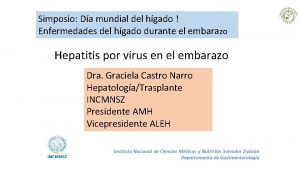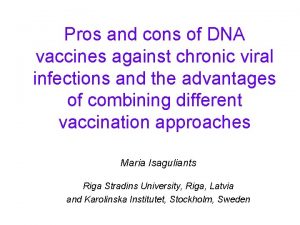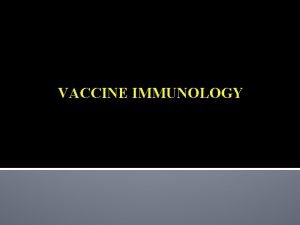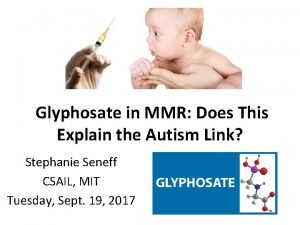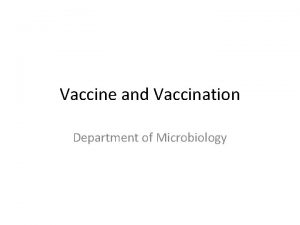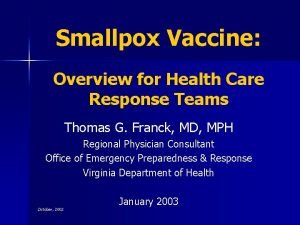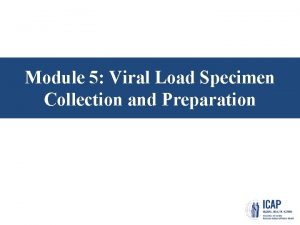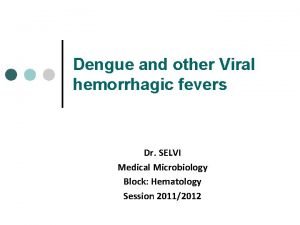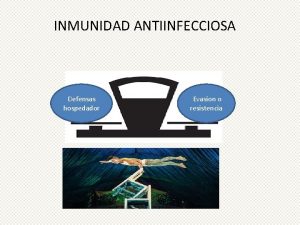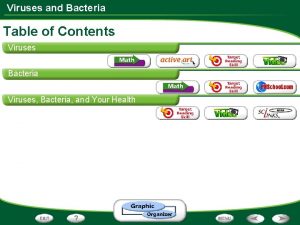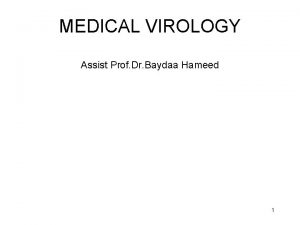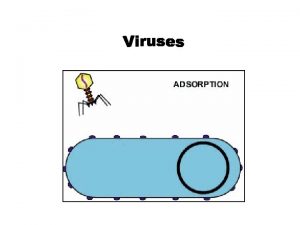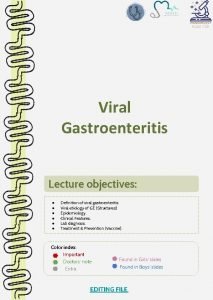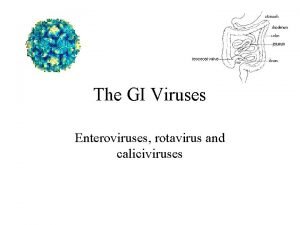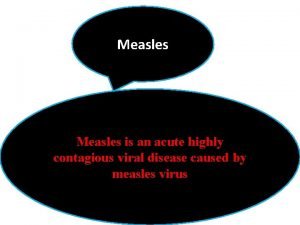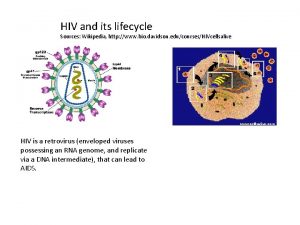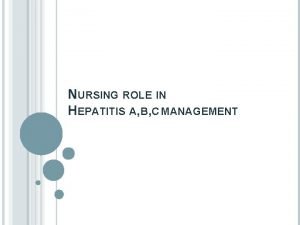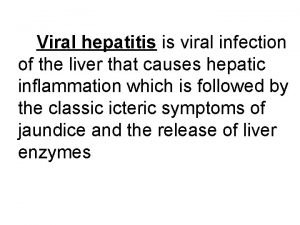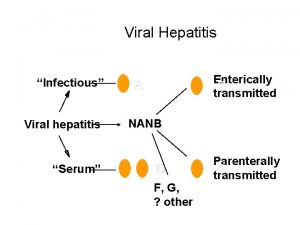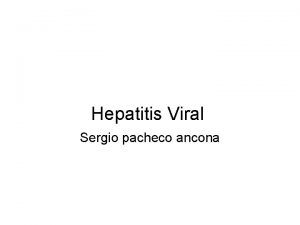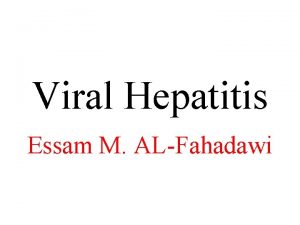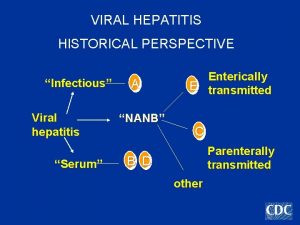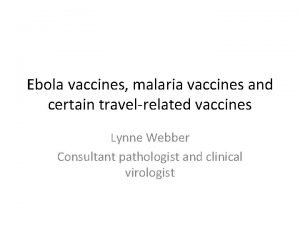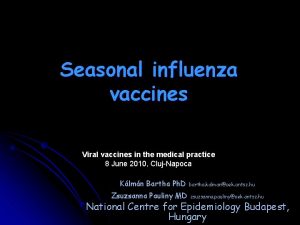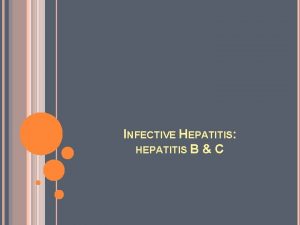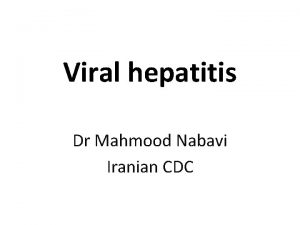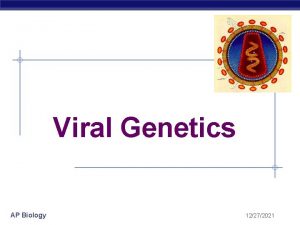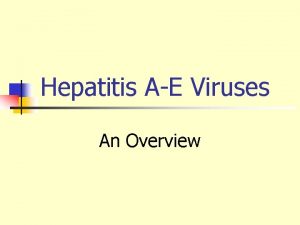Chapter 2 Viral Hepatitis and Hepatitis Vaccines Copyright




























































- Slides: 60

Chapter 2 Viral Hepatitis and Hepatitis Vaccines Copyright © 2010 Wolters Kluwer Health | Lippincott Williams & Wilkins

Viral Hepatitis – Overview • Major HCP occupational concern • At least 7 distinct viruses identified – Short & long incubation intervals – Acute & chronic disease • Variable & subclinical symptomatology Copyright © 2010 Wolters Kluwer Health | Lippincott Williams & Wilkins

RNA Viruses Involved in Human Hepatitis • Picornaviruses (enteroviruses) – HAV, HDV, Coxsackie & Echo viruses • Flaviviruses – HCV • Calciviruses – HEV • Togaviruses – Yellow fever & rubella viruses Copyright © 2010 Wolters Kluwer Health | Lippincott Williams & Wilkins

RNA Viruses Involved in Human Hepatitis (cont’d) • Arenavirus – Junin virus – Machup virus – Lassa virus – Rift Valley Fever virus Copyright © 2010 Wolters Kluwer Health | Lippincott Williams & Wilkins

RNA Viruses Involved in Human Hepatitis (cont’d) • Rhabdoviruses – Marburg virus – Ebola virus • Paramyxovirus – Measles virus Copyright © 2010 Wolters Kluwer Health | Lippincott Williams & Wilkins

DNA Viruses Involved in Human Hepatitis • Hepadnavirus – HBV • Herpesviruses – Cytomegalovirus – Epstein-Barr – Herpes simplex • Varicella-Zoster virus Copyright © 2010 Wolters Kluwer Health | Lippincott Williams & Wilkins

Unclassified Viruses Involved in Human Hepatitis • Hepatitis F virus • Hepatitis G virus • Transfusion-Transmitted virus (TTV) Copyright © 2010 Wolters Kluwer Health | Lippincott Williams & Wilkins

Comparison of Major Microbiological and Clinical Features of Viral Hepatitis Copyright © 2010 Wolters Kluwer Health | Lippincott Williams & Wilkins

Classical Division of Hepatitis Conditions • Prodromal phase • Icteric phase – Marked by jaundice • Convalescent phase Copyright © 2010 Wolters Kluwer Health | Lippincott Williams & Wilkins

Prodromal Phase • Non-specific respiratory and/or GI symptoms – Malaise, loss of appetite, headache & nausea • Any fever usually low-grade • HBV produces symptoms before seroconversion – Arthritis & maculopapular skin rashes Copyright © 2010 Wolters Kluwer Health | Lippincott Williams & Wilkins

Icteric Phase • Jaundice – yellowing – Skin, sclera, mucosa, nail beds & gingiva – By bilirubin & other bile pigments – Hallmark hepatitis manifestation • Dark & foamy urine • Grayish-white stool color Copyright © 2010 Wolters Kluwer Health | Lippincott Williams & Wilkins

Icteric Phase (cont’d) • Most infections may not cause jaundice • Elevated liver enzymes before/at clinical onset – Aminotransferase & transaminases • Hepatitic tenderness, hepatomegaly & splenomegaly Copyright © 2010 Wolters Kluwer Health | Lippincott Williams & Wilkins

Convalescent (Recovery) Phase • Icteric manifestations disappear • Malaise & fatigue may persist for months • Possible long-term, chronic sequelae Copyright © 2010 Wolters Kluwer Health | Lippincott Williams & Wilkins

Question 1 Persons with hepatitis A are most infectious A) During the incubation period. B) Early in the prodromal phase. C) In the last 2 weeks of the prodromal phase. D) Immediately after the onset of jaundice. E) During the convalescent phase. Copyright © 2010 Wolters Kluwer Health | Lippincott Williams & Wilkins

Answer Persons with hepatitis A are most infectious C) In the last 2 weeks of the prodromal phase. The greatest infectivity potential occurs during the 2‑week period immediately before the onset of jaundice. Onset of symptoms is rapidly followed by a decrease in both viremia and infectiousness. Copyright © 2010 Wolters Kluwer Health | Lippincott Williams & Wilkins

Hepatitis A • Picornavirus family • Small, single-stranded 27 nm RNA agent • Humans are only natural host • More temperature & p. H stable than enteroviruses – Remains infectious at moderate temp & low p. H Copyright © 2010 Wolters Kluwer Health | Lippincott Williams & Wilkins

Hepatitis A (cont’d) • Survives in feces & exudates • Stable in environment for months – Inanimate surfaces • Inactivated by high temperature, formalin & chlorine Copyright © 2010 Wolters Kluwer Health | Lippincott Williams & Wilkins

Hepatitis A (cont’d) • First described in 1973 • Common in many developing countries • Decreasing incidence in U. S. – 42, 000 new infections in 2005 (CDC estimate) – Still >30% of reported acute hepatitis cases Copyright © 2010 Wolters Kluwer Health | Lippincott Williams & Wilkins

Hepatitis A Transmission • Person-to-person contact • Fecal-oral contamination • Indirect via contaminated water or food – Raw or inadequately cooked shellfish • 45% of U. S. cases have no known risk factors Copyright © 2010 Wolters Kluwer Health | Lippincott Williams & Wilkins

Risk Factors for Hepatitis A Transmission • Day care center contact • International travel • Intravenous drug use • Men who have sex with men • Persons with chronic liver disease Copyright © 2010 Wolters Kluwer Health | Lippincott Williams & Wilkins

Hepatitis A Transmission and Epidemiology • Serial human-human propagation – No carrier state or chronic hepatitis • Incubation period of 15 - 40 days (average 28 – 30) • Highest infectivity in late incubation to early prodromal – Viremia decreases rapidly after symptom onset Copyright © 2010 Wolters Kluwer Health | Lippincott Williams & Wilkins

Hepatitis A Serology Copyright © 2010 Wolters Kluwer Health | Lippincott Williams & Wilkins

Hepatitis A Serology (cont’d) • Ig. M-class anti-HAV during/soon after acute phase • Ig. G antibodies replace anti-HAV – High concentration in 4 – 6 weeks – Remain detectable thereafter – Confer lifelong protection against HAV Copyright © 2010 Wolters Kluwer Health | Lippincott Williams & Wilkins

Hepatitis A Vaccines • Inactivated hepatitis A virus • VAQTA, Havrix (1995) & Twinrix (2001) • For children in high-incidence areas (CDC, 1999) • Recommended for all children (2006) Copyright © 2010 Wolters Kluwer Health | Lippincott Williams & Wilkins

Hepatitis B • Seroprevalence varies greatly worldwide • Most transmissions perinatal where endemic • Causes 80% of primary liver cancers • U. S. incidence decreasing – Vaccine & infection control precautions Copyright © 2010 Wolters Kluwer Health | Lippincott Williams & Wilkins

Prevalence of Hepatitis B in U. S. • 260, 000 infected in the 1980’s • 78, 000 infected in 2001 • 51, 000 infected in 2005 • 1 million carriers – 20% - 40% will develop life-threatening conditions Copyright © 2010 Wolters Kluwer Health | Lippincott Williams & Wilkins

HBV and Antigens Copyright © 2010 Wolters Kluwer Health | Lippincott Williams & Wilkins

Hepatitis B Virus Morphology • 42 nm, double‑shelled DNA virus • Complete virion is called the Dane particle • Several well‑defined antigen‑antibody systems – Hepatitis B surface antigen (HBs. Ag) – Core antigen (HBc) – Hepatitis B e antigen (HBe. Ag) Copyright © 2010 Wolters Kluwer Health | Lippincott Williams & Wilkins

Serologic Pattern of Acute Hepatitis B Infection Copyright © 2010 Wolters Kluwer Health | Lippincott Williams & Wilkins

Hepatitis Terminology Copyright © 2010 Wolters Kluwer Health | Lippincott Williams & Wilkins

Interpretation of the Hepatitis B Serologic Profiles Copyright © 2010 Wolters Kluwer Health | Lippincott Williams & Wilkins

Outcomes of Hepatitis B Infection Copyright © 2010 Wolters Kluwer Health | Lippincott Williams & Wilkins

Serologic Profile of HBV Carrier State Copyright © 2010 Wolters Kluwer Health | Lippincott Williams & Wilkins

Hepatitis B Clinical Course • Incubation period of 50 – 180 days (average 60 – 120) • Variety of ultimate outcomes • Chronic infection in ~ 5 -10% of adolescents & adults • Most cases anicteric (no jaundice) • As many as 80% of infections undiagnosed Copyright © 2010 Wolters Kluwer Health | Lippincott Williams & Wilkins

Clinical Signs And Symptoms of Acute Hepatitis B Infection • Anorexia • Jaundice • Malaise • Skin rashes • Nausea • Arthralgia • Vomiting • Arthritis • Abdominal pain Copyright © 2010 Wolters Kluwer Health | Lippincott Williams & Wilkins

Symptoms of Chronic HBV Infection • Disease-specific • Nausea – Cirrhosis • Anorexia – Hepatocellular carcinoma • Upper right quadrant tenderness • Severe fatigue Copyright © 2010 Wolters Kluwer Health | Lippincott Williams & Wilkins

HBV Transmission Modes • Parenteral – Percutaneous – efficient, 7+ day incubation – Non-percutaneous – inefficient, ~54 d incubation • Longer period to transmit disease • Sexual • Vertical (perinatal & parent-child contact) Copyright © 2010 Wolters Kluwer Health | Lippincott Williams & Wilkins

Prevalence of Hepatitis B Serologic Markers Among DHCP (1979 -81) Copyright © 2010 Wolters Kluwer Health | Lippincott Williams & Wilkins

Prevalence of HBV Infection in Dentistry • 13. 6% of general practitioners positive in 1976 • 8. 5% of dentists & 6. 8% of hygienists positive in 2005 • Greater exposure risk than general population – General dentists: 3 x risk – Oral surgeons: 6 x risk Copyright © 2010 Wolters Kluwer Health | Lippincott Williams & Wilkins

HBV Transmission from Carrier Dentists to Patients Copyright © 2010 Wolters Kluwer Health | Lippincott Williams & Wilkins

Active Immunity • Antigens stimulate immune response • Long-term protection after a latent period • Conferred by – Host recovery from infection – Vaccination Copyright © 2010 Wolters Kluwer Health | Lippincott Williams & Wilkins

Passive Immunity • Antibodies from actively immunized host – Ig (ISG) – against HAV primarily, inexpensive – HBIG – against HBV for 2 months, expensive • Protection immediate & transitory Copyright © 2010 Wolters Kluwer Health | Lippincott Williams & Wilkins

Plasma-Derived HBV Vaccine (1982) • Serum from carriers, high HBs. Ag concentration – Boiled 1 minute (Krugman, et al. ) – Lost infectivity & retained antigenicity • Viral coat protein extraction & purification • No HIV transmission risk • Heptavax‑B discontinued in 1989 Copyright © 2010 Wolters Kluwer Health | Lippincott Williams & Wilkins

Antibody Responses to Hepatitis B Three. Injection Vaccine Series Copyright © 2010 Wolters Kluwer Health | Lippincott Williams & Wilkins

Recombinant DNA HBV Vaccines (1986) • Gene for HBs. Ag inserted into yeast plasmid • HBs. Ag harvested from lysed yeast cells • Final product has 10 μg HBs. Ag protein/m. L • Recombivax‑HB & Engerix‑B Copyright © 2010 Wolters Kluwer Health | Lippincott Williams & Wilkins

Pre-Testing (HBV Vaccination) • Cost-effective when prevalence high – Anti-HBs-positive persons don’t need vaccine • Not cost-effective in average dental office – Only 6. 7% of DHCP are positive • May be offered per 1991 OSHA BBP Standard • Significant number of false-positives Copyright © 2010 Wolters Kluwer Health | Lippincott Williams & Wilkins

Post-Testing (HBV Vaccination) • Preferably 1 -2 months after 3 rd inoculation • Second 3 -dose course for non-responders • After years, anti-HBs-negative recipient may be – Primary non-responder, susceptible – Antibody level undetectably low, immune Copyright © 2010 Wolters Kluwer Health | Lippincott Williams & Wilkins

Question 2 After administration of hepatitis B vaccine, blood should be tested for A) HBs. Ag within 1 -2 months. B) Anti-HBs within 6 months. C) HBs. Ag every 10 years. D) Anti-HBs every year. E) Both A and D Copyright © 2010 Wolters Kluwer Health | Lippincott Williams & Wilkins

Answer After administration of hepatitis B vaccine, blood should be tested for B) Anti-HBs within 6 months. HBs. Ag (surface antigen) indicates infection, not immunity. Post‑testing should be scheduled soon after the last inoculation, preferably within 1 -2 months, because antibody levels may become undetectably low over time. Annual testing is not required because the protective anamnestic response is very long-term, even if anti-HBs is no longer detectable. Copyright © 2010 Wolters Kluwer Health | Lippincott Williams & Wilkins

Acute HCV Infection Copyright © 2010 Wolters Kluwer Health | Lippincott Williams & Wilkins

Hepatitis C • RNA virus related to genera Flavivirus & Pestivirus • Strains exhibit high genetic diversity – Mutation within host during replication – Very high (85%) rate of chronic infection – No vaccine or PEP available Copyright © 2010 Wolters Kluwer Health | Lippincott Williams & Wilkins

Hepatitis C – Transmission • Illegal intravenous drug use – 60% • Other routes have low transmission rates • Transmitted inefficiently by occupational exposures – 1. 8% of percutaneous exposures • Low risk from environmental contamination Copyright © 2010 Wolters Kluwer Health | Lippincott Williams & Wilkins

Hepatitis C – Acute Infection • Incubation period 30 – 150 days • 60%-70% have no or nonspecific symptoms • Less hepatic inflammatory response vs. HAV & HBV Copyright © 2010 Wolters Kluwer Health | Lippincott Williams & Wilkins

HCV Infection in Dentistry • Prevalence among HCP has declined • Similar incidence as general population (1%-2%) • Risk of surgeon to patient transmission (0. 17%) • Limited risk of DHCP to patient transmission Copyright © 2010 Wolters Kluwer Health | Lippincott Williams & Wilkins

Schematic Morphology of HDV Copyright © 2010 Wolters Kluwer Health | Lippincott Williams & Wilkins

Delta Hepatitis • Requires HBV as helper virus – Outer protein coat (HBs. Ag) & replication – Active HBV immunity protects against HDV • Endemic in Mediterranean, parts of Africa & S. America – Transmitted by intimate contact & transmucosally • Transmitted percutaneously where not endemic Copyright © 2010 Wolters Kluwer Health | Lippincott Williams & Wilkins

HDV Infection Modes • Simultaneous infection with HBV and HDV – Often resolves with limited clinical course • Acute delta superinfection in HBV carriers – Already have high titer of circulating HBs. Ag – More serious, fulminating & chronic infections Copyright © 2010 Wolters Kluwer Health | Lippincott Williams & Wilkins

Hepatitis E Virus • Single-stranded RNA calcivirus • Transmitted enterically via fecal-oral route • No outbreaks in U. S. , Europe or Australia • Very low transmission risk in occupational exposures • Incubation period 15 – 70 days • Generally self-limiting, except during pregnancy Copyright © 2010 Wolters Kluwer Health | Lippincott Williams & Wilkins

Question 3 Which of the following requires an additional etiologic agent for clinical expression? A) Hepatitis A virus B) Hepatitis B virus C) Hepatitis C virus D) Hepatitis D virus E) Hepatitis E virus Copyright © 2010 Wolters Kluwer Health | Lippincott Williams & Wilkins

Answer Which of the following requires an additional etiologic agent for clinical expression? D) Hepatitis D virus Although HDV is unique and distinct from HBV, it requires HBV as a helper virus for an outer protein coat (HBs. Ag), and thus for replication. Copyright © 2010 Wolters Kluwer Health | Lippincott Williams & Wilkins
 Hgado
Hgado Virulent
Virulent Edible vaccines pros and cons
Edible vaccines pros and cons Advantages and disadvantages of vaccines ppt
Advantages and disadvantages of vaccines ppt Global alliance for vaccines and immunization
Global alliance for vaccines and immunization Edible vaccines pros and cons
Edible vaccines pros and cons Is glyphosate in vaccines
Is glyphosate in vaccines Edible vaccines in pharmacognosy
Edible vaccines in pharmacognosy Stephanie seneff mit vaccines
Stephanie seneff mit vaccines Immune checkpoint inhibitors mechanism of action
Immune checkpoint inhibitors mechanism of action Tuberculose transmission
Tuberculose transmission Could vaccines breed viciousness
Could vaccines breed viciousness Hep b vaccines
Hep b vaccines Virulent
Virulent Hep b vaccines
Hep b vaccines Freeze market
Freeze market Brighton collaboration case definitions for vaccines
Brighton collaboration case definitions for vaccines Spacing out vaccines
Spacing out vaccines Section 24-1 viral structure and replication
Section 24-1 viral structure and replication Aerochamber definition
Aerochamber definition Vrus
Vrus Pantropizm
Pantropizm Method of cultivation of virus
Method of cultivation of virus Viral inoculation in embryonated egg
Viral inoculation in embryonated egg Virus cultivation in embryonated eggs
Virus cultivation in embryonated eggs Spasmodic croup
Spasmodic croup Variola varicela
Variola varicela Decapsidação
Decapsidação Hemolyzed serum sample
Hemolyzed serum sample Tratamiento meningitis viral
Tratamiento meningitis viral Causes of viral hemorrhagic fever
Causes of viral hemorrhagic fever Ciclo viral
Ciclo viral Capsid capsomere
Capsid capsomere Viral
Viral Viral recombination
Viral recombination Vaccins à vecteur viral
Vaccins à vecteur viral Viral receptors
Viral receptors Procalcitonin
Procalcitonin Equine synonym
Equine synonym Viral dna
Viral dna Viral gastroenteritis
Viral gastroenteritis Viral entry
Viral entry The dynamics of viral marketing
The dynamics of viral marketing Csf findings in meningitis table
Csf findings in meningitis table Viral arthritis
Viral arthritis An acute highly contagious viral disease
An acute highly contagious viral disease Viral life cycle
Viral life cycle Antiperytique
Antiperytique Viral shedding
Viral shedding Eline's viral
Eline's viral Andrew lippman mit
Andrew lippman mit Hiv life cycle wikipedia
Hiv life cycle wikipedia Vacinas subcutânea
Vacinas subcutânea Hepatitis symptoms
Hepatitis symptoms Hepatitis types table
Hepatitis types table Hepatitis e
Hepatitis e Window period of hepatitis b
Window period of hepatitis b Symptoms of gonorrhea
Symptoms of gonorrhea Std refers to *
Std refers to * Infeccion por vph
Infeccion por vph Dieta hepatitis
Dieta hepatitis
